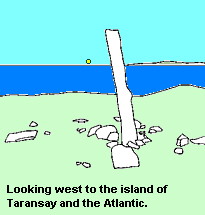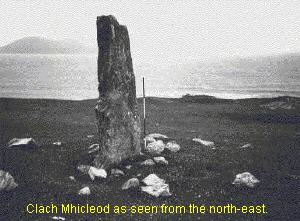
Clach Mhicleoid, Harris
Stones
of Wonder
QUICK LINKS ...
HOME PAGE
INTRODUCTION
WATCHING
THE SUN, MOON AND STARS
THE
MONUMENTS
THE
PEOPLE AND THE SKY
BACKGROUND
ARCHAEOASTRONOMY
USING
THE SITE DESCRIPTION PAGES
VISITING
THE SITES
THE
LEY LINE MYSTERY
THE
SITES
ARGYLL
AND ARRAN
MID
AND SOUTH SCOTLAND
NORTH
AND NORTH-EAST SCOTLAND
WESTERN
ISLES AND MULL
Data
DATES
OF EQUINOXES AND SOLSTICES, 1997 to 2030 AD
DATES
OF MIDSUMMER AND MIDWINTER FULL MOONS, 1997 to 2030 AD
POSTSCRIPT
Individual
Site References
Bibliography
Links
to other relevant pages
Contact
me at : rpollock456@gmail.com
Standing Stone NG041973*
How to find: Follow the A859 road south from Tarbert for 18km, travelling through what must surely be the rockiest landscape in Scotland, until you reach Horgabost. After passing a small promontory a roadside sign indicates the stone, which is visible from the parking place, on a low hill beyond the far end of the beach.
Best time of year to visit: Equinoxes, about March 20th and September 22nd.
 This
is an impressive and dramatically situated stone, on a grassy slope above
a perfect and usually empty Hebridean beach. It is a tall stone, over
three metres high, with the packing stones at the base visible; it is
150cm wide but only 40cm thick, and so presents two flat faces which draw
the eye out over the sea.
This
is an impressive and dramatically situated stone, on a grassy slope above
a perfect and usually empty Hebridean beach. It is a tall stone, over
three metres high, with the packing stones at the base visible; it is
150cm wide but only 40cm thick, and so presents two flat faces which draw
the eye out over the sea.
This stone is also a good example of the debate about the evidence which the stones present. Alexander Thom interpreted Clach Mhicleoid as the backsight for the line to the distant islands of the St. Kilda group, fully 90km out in the ocean, the tops of which can be seen in clear weather.1 The bearing to the most northerly and highest island of the St Kilda group, Boreray, is 271° and gives a declination of 0°, that of the setting sun at the equinoxes, when day and night are of equal length.
This interpretation of the stone as a prehistoric astronomical marker may be correct, as stones from a later period erected on shorelines to be seen from the sea usually have their wide face turned seawards, whereas Clach Mhicleoid is at right angles to the sea.
 However,
a survey of the stone's indicated bearings on the horizon gives a value
of 275° for the left-hand side and 282.5° for the right. The stone
leans to the south, and if it were originally vertical would have indicated
an azimuth of about 290.5°. None of these azimuths produces a significant
declination value.
However,
a survey of the stone's indicated bearings on the horizon gives a value
of 275° for the left-hand side and 282.5° for the right. The stone
leans to the south, and if it were originally vertical would have indicated
an azimuth of about 290.5°. None of these azimuths produces a significant
declination value.
So the stone doesn't actually point towards Boreray. Even with the better weather in the Neolithic and Early Bronze age period, the number of days of the year when the island of Boreray could be seen at all must have been very limited.
Whether you would accept the stone
as simply indicating the place to stand and an approximate indication
of the direction in which to look, or whether you believe some more definite
indication is required before such a line could be accepted is a personal
choice. But a visit to this part of the Hebrides is an experience not
to be missed.